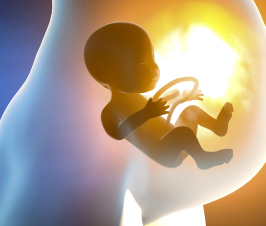Bringing a new baby into the world is a great gift and a great responsibility. Mother and child develop a special bond both mentally and physically. The placenta is an entirely new organ created to provide oxygen and nutrients to the unborn child. What has recently come to light is that the placenta does not protect the fetus from harmful toxins as we once expected. While nutrients are being provided to the fetus, simultaneously, potent disrupters of development are smuggled across the placenta. A 2004 study completed by the Environmental Working Group and Commonweal found an average of 200 chemicals in the umbilical cord blood of 10 babies born between August and September 2004. In total, 287 chemicals were found in cord blood. These chemicals are known to cause cancer, hormone irregularities, birth defects and brain toxicity in mice studies. Due to the nature of environmental medicine, it is extremely difficult to pinpoint the long-term side of any single chemical on human health. However, studies do correlate high levels of these chemicals with adverse side effects in humans.1
Toxicity
High toxin levels in umbilical cord blood demonstrate that newborns are born with a preexisting toxic burden. The fetus and newborn are significantly more susceptible to toxic exposure than adults due to their small size, rapidly developing system and incomplete defense mechanisms. An undeveloped blood brain barrier allows chemicals to slowly percolate into the brain. The fetus and newborn have reduced ability to detoxify giving chemicals more time to do damage on their nascent physiology.
The quantity of synthetic chemicals that the average American is exposed to is too numerous to list. Four of the widely found chemicals that are known to do damage include Phthalates, Bisphenol A, Dioxins and Polybrominated diethyl esters.
Phthalates, also known as plasticizers, are common chemicals used to make plastics more flexible and difficult to break. Phthalates are ubiquitous due to their use in everything from synthetic flooring to toys to hair care products and cosmetics. Exposure can be from breathing phthalate vapors or eating or drinking items contained in phthalate products. Phthalates have been proven to act as endocrine disruptors in mice studies. It is purported that due to their interference with hormones, brain development may be hindered by their presence.2 One human study exhibited lower IQ scores in 7-year-old children that were exposed to phthalates in the womb. 328 New York women of African or Dominican American descent and their children, born between 1999 and 2006, were followed for prenatal testing and later IQ testing of the children. The children of women with high levels of 2 phthalate metabolites (di-n-butyl phthalate (DnBP) and di-isobutyl phthalate (DiBP)) were found to have IQ scores 6-8 points lower than children of mothers with low levels of the indicated phthalates. Particularly speed of thought process and non-verbal communication were worst in the highly exposed children. Despite the unclear mechanism of action, it is evident that exposure to phthalates in the womb are likely to result in reduced IQ.3
BPA or Biphenol A is another common toxin Americans are persistently exposed to. Most people know that BPA is used in plastic dishware items including sippy cups and bottle. What is not as widely understood is that most cans and cardboard cartons, as well as, dental sealants are also lined with BPA. Water used for drinking and bathing is concerns of BPA exposure due to the significant amount of leaching of BPA from landfills.4 Since 2004 there have been over 115 studies on the low-dose effects of BPA. Low-dose is qualified as below the predicted safe level of 50 mcg/kg/day. Heat or contact with acidic compounds (like lemon, tomato, soda) increases the leaching of BPA. Rate of growth and sexual maturation, hormone levels in blood, reproductive organ function, fertility, immune function, enzyme activity, brain structure, brain chemistry, and behavior are all affected by exposure to low doses of BPA. Many of these effects are due to exposure during early development.5 Recently there has been a movement to remove BPA from plastics, particularly plastics designed for children. The sad fact about the alternatives to BPA is that there is no evidence that they are any safer.
Dioxins are an environmental pollutant known as Persistent Organic Pollutants or POPs. Dioxins have a long chemical stability and are easily absorbed and stored in fatty tissue. Therefore, despite the fact that Dioxins and other polychlorinated biphenyls have been banned since 1979, they continue to persist in our environment.6 Studies have found dioxins to cause problems in numerous organs and physiological systems. Most commonly associated with industrial processes, Dioxins are also a by-product of volcanic eruptions and forest fires. Some of the commonly found exposures to dioxins include meat such as poultry, beef and chicken. This is due to animal food contamination with industrial waste high in dioxins. Like all environmental studies on humans, Dioxin studies are limited and poorly controlled. Needless to say, in 2003 the EPA released a large paper discussing the potential effects of Dioxins on humans based on known animal studies. Dioxins may increase several types of cancer. Fish, bird and mammal populations have reproductive and developmental problems from high exposure to dioxins. Evidence also suggests that high exposure to dioxins result in reduced immunity.7
Polybrominated Diethyl Ester (PBDE) is a chemical added to anything from couches to pajamas to act as a fire retardant. PBDE’s can leak into ground water or be absorbed through the skin. Humans are also exposed to PBDE’s by eating meat, as PBDE’s bio-accumulate in the fat of animals. Therefore fish high on the food chain, such as tuna and swordfish, are likely to have higher levels of PBDE than a smaller fish such as anchovies.8 Studies proving the harmful effects of PBDE’s on humans are difficult to create, but studies on animals have been shown to cause reduced immune function, fertility problems, increase in certain types of cancer, reduced cognitive function and thyroid dysfunction. A cohort study of 309 women in Ohio found that PBDE exposure (specifically BDE47) correlate with a decrease in full-scale IQ after a five-year period and an increase in hyperactivity, suggesting that PBDEs may be neurotoxicants.9
Now what? Toxins surround us every day. This article only touched on four of the major toxins we see in umbilical cord blood and newborns, but the reality is that there are an abundance of naturally occurring and synthetic toxins that we breathe in and consume daily. The good news is that awareness is the first step towards reducing you and your unborn child’s burden. There are many things you can do to reduce toxicity.
Tips for Reduced body burden
- Go buy a glass water bottle. If you must choose plastic, avoid products labeled 3, 6 or 7.
- Avoid microwaving food in plastic or putting hot food in plastic containers.
- Know your food sources. Both animal and vegetable may be contaminated so go local and pasture raised as much as possible to avoid unknown exposures.
- Be aware of the products that you place on your body.
- Buy a carbon water filter for your sink and shower that will remove many environmental toxins.
- Drink at least 80 ounces of water daily.
- Eat a diet high in fruits and vegetables. These are the foods that help your liver to detoxify.
- Consider lab testing to assess body burden.
The bottom line is that there is no way to avoid the numerous toxins we are exposed to on a daily basis. Multiple chemical exposures are likely to result in numerous side effects that will cause long-term detriment to human health. Awareness and prevention are the best ways to move forward and live a healthy life creating a healthier environment.
 Dr Knapp believes in the symbiosis of humanity and the environment. It was during her work as a small farmer after college that Dr Knapp recognized her goal to heal the earth by helping its inhabitants heal themselves.
Dr Knapp believes in the symbiosis of humanity and the environment. It was during her work as a small farmer after college that Dr Knapp recognized her goal to heal the earth by helping its inhabitants heal themselves.
Dr Knapp received her Doctorate from the National College of Natural Medicine with a specialty in Natural Childbirth. She currently practices as “a doctor who listens” in Vancouver, WA. Dr Knapp is a member of the AANP, WANP and a writer for the NABNE. Dr Knapp enjoys spending time with her family, preparing meals with locally procured foods and grounding herself by getting her feet wet in any nearby body of water.
About me: I am a fan of all things DIY…leading to many less than perfect projects in the home. I love to play indoors or out with my family, preparing meals with locally procured foods and grounding myself by getting my feet wet in any nearby body of water.
References:
- Body Burden: The Pollution in Newborns. (July 14, 2005) Retrieved from: http://www.ewg.org/research/body-burden-pollution-newborns
- National Biomonitoring Program. Phthalates Fact Sheet.Retrieved from: http://www.cdc.gov/biomonitoring/phthalates_factsheet.html Date July 16 2013
- Factor-Litvak, P, Insel, B, CAlafat, A, Perera, F, Rauh, V, Whyatt, R. (2014) Persistant Associations between Maternal Prenatal Exposure to Phthalates on Child IQ at Age 7 Years. Plos One DOI: 10.1371/journal.pone.0114003
- National Biomonitoring Program. BPA Fact Sheet.Retrieved from: http://www.cdc.gov/biomonitoring/BisphenolA_FactSheet.html Date July 16 2013
- Frederick S. vom Saal and Claude Hughes. An Extensive New Literature Concerning Low-Dose Effects of Bisphenol A Shows the Need for a New Risk Assessment. Environ Health Perspect. Aug 2005; 113(8): 926–933.Published online Apr 13, 2005.doi: 1289/ehp.7713
- National Biomonitoring Program. Dioxins Fact Sheet.Retrieved from: http://www.cdc.gov/biomonitoring/DioxinLikeChemicals_FactSheet.html Date July 16 2013
- Exposure and Human Health Reassessment of 2,3,7,8-Tetrachlorodibenzo-p-Dioxin (TCDD) and Related Compounds. National Center for Environmental Protection. Retrieved from www.epa.gov/ncea/dioxin.
- National Biomonitoring Program. PBDEs Fact Sheet.Retrieved from: http://www.cdc.gov/biomonitoring/PBDEs_FactSheet.html Date July 16 2013
- Chen, A, Yolton, K, Rauch, S, Webster, G, Hornung, R, Sjödin, A, Dietrich, K, Lanphear, B. Prenatal Polybrominated Diphenyl Ether Exposures and Neurodevelopment in US Children Through 5 Years of Age. (2014) Environmental Health Perspectives. Retrieved from: http://ehp.niehs.nih.gov/wp-content/uploads/122/8/ehp.1307562.pdf

















